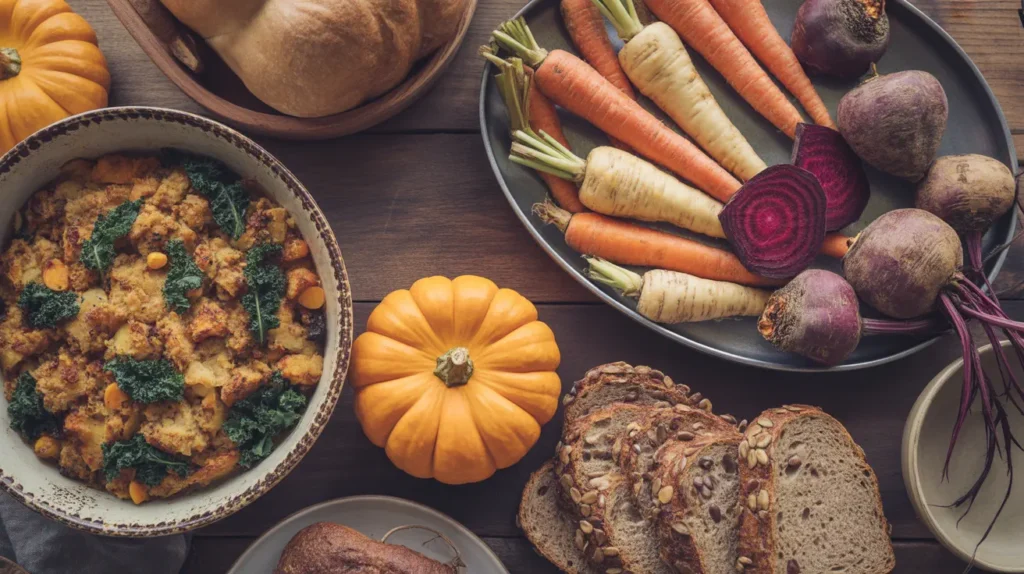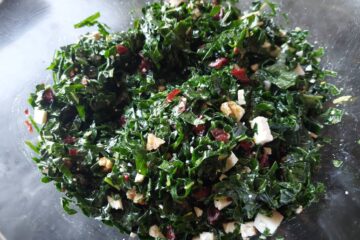Key Takeaways
- Incorporating seasonal produce enhances flavor, nutrition, and sustainability in your Thanksgiving menu
- Fall vegetables like kale, pumpkin, and squash make excellent additions to traditional dishes
- Creative side dishes using seasonal ingredients can become new family favorites
- Advance preparation with seasonal produce helps reduce holiday stress
- Balancing traditional recipes with innovative seasonal twists keeps your menu exciting
- Seasonal cooking promotes sustainability and reduces environmental impact
- Local, in-season produce offers superior flavor and nutritional benefits
- Thoughtful menu planning minimizes food waste during the holiday season
Thanksgiving is a celebration of harvest abundance, making it the perfect occasion to showcase the vibrant flavors of seasonal produce. When we embrace what nature offers during the fall months, we not only improve the taste of our holiday meals but also connect with the true spirit of this traditional feast that has historically celebrated the bounty of a successful harvest season. This connection to agricultural cycles honors the original intention of Thanksgiving while providing the freshest, most flavorful ingredients for your table.
At Whaley Cooks, we believe that seasonal ingredients are the foundation of a memorable Thanksgiving dinner. The rich, earthy flavors of autumn vegetables and fruits complement classic holiday dishes while providing opportunities for creative culinary exploration. Whether you’re preparing a traditional feast or looking to innovate, seasonal produce offers both nutritional benefits and exceptional taste. By choosing ingredients at their peak, you’re not only ensuring maximum flavor but also supporting local agriculture and sustainable food systems, making your holiday celebration more environmentally conscious and community-oriented.

In this guide, we’ll explore twelve ways to enhance your Thanksgiving menu using the best seasonal produce available. From innovative sides to creative twists on classic dishes, these ideas will help you create a feast that celebrates the bounty of the season while delighting your guests. We’ll provide practical advice for incorporating everything from hearty root vegetables to vibrant fall greens, ensuring your holiday table is as nutritious as it is delicious. These suggestions are designed to inspire both novice and experienced cooks to make the most of autumn’s culinary gifts.
1. Elevate Your Stuffing with Seasonal Greens
Traditional stuffing gets a nutritious and flavorful upgrade when you incorporate seasonal greens like kale. Our Cheesy Winter Green Stuffing with Kale transforms this Thanksgiving staple into a vibrant, nutrient-dense dish that still delivers the comfort food satisfaction your guests crave. The addition of leafy greens not only enhances the nutritional profile by adding vitamins A, C, and K, but also introduces complex flavors and interesting textures that improve this classic side dish to new heights.


The hearty greens and savory cheese create a perfect balance, offering a lighter and healthier twist on the traditional recipe without sacrificing flavor. Kale is at its peak during the fall months, making it an ideal seasonal addition to your Thanksgiving table. The slight bitterness of kale is beautifully balanced by the richness of cheese, creating a complex flavor profile that will have guests coming back for seconds. For even more depth, consider incorporating other seasonal greens like Swiss chard, collards, or spinach, each bringing its own unique characteristics to the dish.
This stuffing pairs wonderfully with both turkey and vegetarian main courses, making it a versatile option for accommodating different dietary preferences. For those looking to explore more side dish options, this kale stuffing is just the beginning of how seasonal greens can transform your holiday menu. The robust texture of kale holds up well to advance preparation, allowing you to assemble this dish a day ahead and simply bake it before serving, reducing day-of kitchen stress and allowing you to focus on other aspects of your meal preparation.
2. Seasonal Soups as Elegant Starters
Begin your Thanksgiving feast with a warming soup that showcases fall’s finest produce. Seasonal soups not only set the tone for the meal ahead but also provide a practical first course that can be prepared days in advance, reducing day-of stress. These comforting starters offer a sophisticated beginning to your holiday meal while helping to pace the dining experience, giving guests something to enjoy while final preparations are being completed in the kitchen.


Butternut squash, pumpkin, and sweet potato soups are classic autumn choices that complement the flavors of a traditional Thanksgiving meal. For something a bit more unexpected, consider a creamy cauliflower soup with crispy sage or a roasted carrot soup with ginger and apple. These delicious soup recipes can be adapted to use whatever seasonal vegetables you have on hand. The natural sweetness of fall vegetables creates soups with remarkable depth of flavor, often requiring minimal additional ingredients to shine.
Serving soup as a starter also helps pace the meal and gives guests something to enjoy while final preparations are being made. Consider offering a small cup rather than a full bowl to avoid filling up your guests before the main event. Garnish with toasted pumpkin seeds, a swirl of cream, or fresh herbs to improve the presentation and add textural contrast. For a special touch, serve the soup in hollowed-out small pumpkins or squash for a stunning visual presentation that reinforces the seasonal theme of your meal. This thoughtful approach to your first course sets the stage for an exceptional dining experience.
3. Showcase Seasonal Salads with Fall Harvest Ingredients
Bright, fresh salads provide a welcome contrast to the rich, heavy dishes typically found on the Thanksgiving table. Creating salads with seasonal produce adds color, texture, and nutritional balance to your holiday spread. These refreshing dishes help cleanse the palate between bites of more indulgent offerings and provide a lighter option that many guests appreciate amidst the abundance of hearty fare.


Fall-inspired salad creations might include roasted beets with goat cheese and walnuts, shaved Brussels sprouts with dried cranberries and pecans, or a medley of roasted root vegetables over mixed greens. The key is to incorporate ingredients that reflect the season while providing a refreshing counterpoint to traditional Thanksgiving flavors. Consider using hearty greens like arugula, endive, or radicchio as your base, as these stand up better to robust fall ingredients than more delicate lettuces.
Consider using seasonal fruits like apples, pears, or pomegranate seeds to add sweetness and visual appeal. A simple vinaigrette with apple cider vinegar and maple syrup captures the essence of fall while allowing the seasonal ingredients to shine. These salads can be partially prepped ahead of time, with final assembly just before serving to maintain optimal freshness and texture. For added convenience, prepare components separately and store them properly, then combine them shortly before the meal begins. This approach ensures your salad maintains its crisp textures while saving valuable time during the busy hours before your Thanksgiving dinner is served.
4. Reimagine Root Vegetables as Thanksgiving Stars
Root vegetables reach their peak flavor during the fall harvest, making them perfect candidates for Thanksgiving side dishes that go beyond the expected. Their natural sweetness intensifies when roasted, creating dishes that are both comforting and sophisticated. These underground treasures—including carrots, parsnips, turnips, beets, and rutabagas—develop caramelized exteriors and tender interiors when properly cooked, offering complex flavors that complement the traditional centerpieces of the Thanksgiving table.


Consider a medley of roasted carrots, parsnips, turnips, and rutabagas tossed with herbs and a touch of maple syrup. Or try a gratin of layered sweet potatoes, celery root, and butternut squash for an elegant presentation. These dishes highlight the seasonal produce while providing hearty, satisfying options for your holiday table. The varying colors, textures, and flavors of different root vegetables create visual interest and culinary excitement when combined thoughtfully.
Root vegetables also lend themselves beautifully to purees and mashes that can be prepared in advance and reheated. A silky parsnip puree or a colorful mash of sweet potatoes and carrots offers familiar comfort with unexpected flavors. For added interest, incorporate seasonal herbs like sage, thyme, and rosemary, which complement the earthy sweetness of root vegetables perfectly. Consider preparing these dishes with vegetable stock instead of cream or butter to create lighter options that accommodate dairy-free guests while still delivering satisfying richness and depth of flavor. The versatility of root vegetables makes them ideal candidates for both traditional and innovative approaches to Thanksgiving cooking.
5. Artisanal Bread with Seasonal Add-ins
Homemade bread with seasonal ingredients adds a special touch to your Thanksgiving spread. Our Pumpkin, Sunflower and Flax Seed Whole-wheat and Rye Sourdough Bread is a perfect example of how fall ingredients can transform a simple staple into a seasonal showstopper. The process of baking bread from scratch fills your home with an irresistible aroma that creates a warm, welcoming atmosphere for guests while showcasing your culinary skills and attention to detail.

This nutrient-rich bread is not only delicious on its own but also serves as the perfect canvas for sopping up gravy and enjoying with soups. The addition of pumpkin provides moisture and subtle sweetness, while the seeds add texture and nutritional benefits. The whole wheat and rye flours create a hearty base that stands up well to the robust flavors of a Thanksgiving meal. The complex fermentation process of sourdough bread develops deep flavors that pair beautifully with the earthy, savory components of your holiday feast.
If you’re not up for baking sourdough, consider simpler options like pumpkin dinner rolls, rosemary focaccia, or cranberry-walnut quick bread. These can often be prepared a day or two in advance, freeing up valuable oven space on Thanksgiving Day. Fresh bread also makes for excellent leftovers, perfect for creating sandwiches with turkey and all the trimmings in the days following the feast. The versatility of seasonal bread extends beyond the main meal, providing delicious options for breakfast toast or midnight snacks throughout the holiday weekend. By incorporating seasonal ingredients into your bread, you create another opportunity to highlight the flavors of fall while providing a comforting, familiar element that guests of all ages will appreciate.
6. Creative Seasonal Appetizers for Pre-Dinner Grazing
Keep guests satisfied before the main meal with appetizers that showcase seasonal ingredients. These small bites set the tone for the feast to come while highlighting the flavors of fall. A thoughtfully planned selection of appetizers helps manage the pacing of your gathering, preventing guests from becoming overly hungry while allowing for social mingling before everyone sits down to the main meal.


Our creative seasonal appetizer ideas include options like butternut squash crostini with sage and brown butter, stuffed mushrooms with herbed breadcrumbs, or sweet potato rounds topped with cranberry relish and goat cheese. These finger foods are not only delicious but also beautiful additions to your holiday spread. The visual appeal of colorful seasonal appetizers creates an inviting atmosphere and builds anticipation for the meal to come.


The key to successful Thanksgiving appetizers is keeping them light enough that guests don’t fill up before the main event. Focus on small portions with big flavors, using seasonal ingredients to create memorable first impressions. Many of these can be prepared in advance and served at room temperature, allowing you to focus on final dinner preparations while guests enjoy these pre-meal treats. Consider creating a balanced selection that includes both vegetable-forward options and protein-rich choices to satisfy different preferences and dietary needs. Remember that appetizers provide an excellent opportunity to incorporate seasonal ingredients that might not appear elsewhere in your menu, further expanding the range of fall flavors represented in your Thanksgiving celebration.
7. Seasonal Produce in Traditional Side Dishes
Traditional Thanksgiving side dishes gain new life when enhanced with seasonal produce. These familiar favorites provide comfort while showcasing the best ingredients of the season. By thoughtfully incorporating fresh, peak-season vegetables and fruits into classic recipes, you maintain the nostalgic appeal of traditional dishes while improving their flavor, nutritional value, and visual appeal.

Consider updating classic green bean casserole with fresh green beans and wild mushrooms, or improve mashed potatoes by blending in roasted garlic and parsnips. Cranberry sauce made with fresh berries, orange zest, and a hint of cinnamon offers bright flavor that complements the richness of other dishes. These side dish variations honor tradition while incorporating seasonal freshness. The contrast between familiar recipes and unexpected seasonal ingredients creates delightful moments of discovery for your guests, as they recognize beloved dishes presented with thoughtful, creative touches.
The beauty of these updates lies in their familiarity – guests recognize the dishes they love, but discover new dimensions of flavor through the addition of seasonal ingredients. This approach allows you to maintain beloved traditions while subtly improving your Thanksgiving menu with the bounty of the fall harvest. Consider involving family members in the process of updating traditional recipes, perhaps incorporating elements from different cultural backgrounds or regional specialties to create a menu that tells your unique family story while celebrating the universal themes of gratitude and abundance that define the Thanksgiving holiday.
8. Squash Varieties as Versatile Menu Components
Winter squash varieties like butternut, acorn, delicata, and kabocha are quintessential fall ingredients that can play multiple roles in your Thanksgiving menu. Their sweet, nutty flavors and vibrant colors make them both practical and beautiful additions to the holiday table. The remarkable versatility of winter squash allows them to appear in everything from appetizers to desserts, providing a through-line of seasonal flavor that unifies your meal.

From stuffed acorn squash halves that serve as elegant vegetarian main courses to pureed butternut squash soup as a starter, these vegetables can appear throughout your meal in different forms. Roasted delicata rings with maple glaze make a beautiful side dish, while kabocha can be incorporated into a savory bread pudding or stuffing. Each variety brings its own unique characteristics – butternut offers smooth texture ideal for purees, delicata features edible skin that simplifies preparation, acorn creates perfect natural serving vessels, and kabocha provides exceptional sweetness and dense texture.
Squash also works beautifully in creative recipes that blend sweet and savory flavors – think butternut squash risotto with sage and brown butter or roasted squash with cranberries and pecans. Their natural sweetness balances the savory elements of a traditional Thanksgiving meal, creating a harmonious dining experience. Beyond their culinary versatility, winter squash varieties offer impressive nutritional profiles, providing fiber, vitamins, and antioxidants that contribute to a more balanced holiday meal. Their long storage life also makes them practical ingredients to have on hand during the busy holiday season, ready to transform into whatever your menu requires.
9. Incorporating Seasonal Herbs for Flavor Depth
Fresh herbs are at their aromatic best during the fall harvest and can transform ordinary dishes into extraordinary ones with minimal effort. Incorporating seasonal herbs throughout your Thanksgiving menu adds layers of flavor and fragrance that improve the entire dining experience. These botanical ingredients provide bright, complex notes that cut through rich dishes and create memorable flavor combinations that guests will remember long after the meal concludes.
Sage, thyme, rosemary, and parsley are traditional Thanksgiving herbs that pair beautifully with fall produce. Use them to create an herb butter for your turkey, infuse them into gravy, or sprinkle them over roasted vegetables. A simple herb salad with parsley, chives, and dill dressed with lemon and olive oil provides a refreshing counterpoint to rich holiday dishes. The aromatic qualities of these herbs stimulate the senses and enhance the overall dining experience, creating a more immersive and satisfying meal.
Consider creating an herb-focused centerpiece that’s both beautiful and functional – guests can pluck fresh herbs to add to their plates as desired. This not only adds an interactive element to your meal but also ensures that the bright, fresh flavors of seasonal herbs are featured prominently in your Thanksgiving recipes. Herbs can also be used to create infused oils, vinegars, or butters in advance, providing convenient ways to incorporate their flavors throughout your menu while simplifying day-of preparation. The subtle complexity that herbs contribute to your dishes demonstrates culinary sophistication while requiring relatively little additional effort – a perfect combination for the busy holiday cook.
10. Planning for Seasonal Produce Availability
Successful Thanksgiving menu planning requires understanding what’s available and at its peak during the fall season. This knowledge allows you to make the most of seasonal offerings while avoiding disappointment or last-minute substitutions. Developing relationships with local farmers, visiting farmers’ markets, and understanding regional growing seasons helps you anticipate what ingredients will be available and at their best quality when planning your holiday menu.
“The secret to a memorable Thanksgiving feast lies in embracing what nature provides during the fall harvest. When you plan your menu around seasonal availability, you not only ensure the best flavors but also connect with the true spirit of this harvest celebration.”
Research what local farms and markets will have available in the weeks leading up to Thanksgiving. Many farms offer pre-ordering for holiday produce, ensuring you’ll have access to the freshest ingredients. Consider visiting a seasonal produce guide to understand what’s at its peak during November in your region. This advance planning allows you to design a menu that showcases the best of what’s available while minimizing stress about ingredient sourcing during the busy holiday season.
Planning ahead also allows you to be flexible with your menu. If certain ingredients aren’t available or don’t look their best, having knowledge of other seasonal options enables you to make smart substitutions that maintain the integrity of your meal. This approach to menu planning celebrates the natural rhythms of the growing season and results in a more authentic Thanksgiving experience. Consider creating a primary plan with backup options for key ingredients, ensuring you can adapt smoothly to whatever the markets offer in the days leading up to your celebration. This flexibility honors the true spirit of Thanksgiving as a harvest festival that celebrates nature’s bounty, whatever form it may take.
11. Balancing Traditional and Innovative Dishes
Creating a memorable Thanksgiving menu often involves striking the right balance between cherished traditions and fresh innovations. Using seasonal produce allows you to honor classic dishes while introducing new flavors that may become future traditions. This thoughtful approach respects the nostalgia and comfort that many guests associate with Thanksgiving while preventing the meal from becoming predictable or stagnant year after year.



Consider organizing your menu to include “must-have” traditional dishes alongside one or two innovative offerings that showcase seasonal ingredients. This approach satisfies guests who look forward to familiar favorites while also providing pleasant surprises. For example, serve classic mashed potatoes alongside an experimental dish like roasted Brussels sprouts with pomegranate and pistachios. The contrast between traditional and innovative dishes creates a dynamic dining experience that appeals to different preferences while maintaining the comforting essence of the holiday.
Communicate with your guests about the menu in advance, especially if you’re planning significant departures from expected dishes. This preparation helps manage expectations and builds anticipation for new additions. Remember that planning your Thanksgiving dinner thoughtfully ensures both traditional comfort and fresh excitement on your holiday table. Consider documenting successful innovations so they can potentially join your repertoire of traditional dishes in future years, allowing your family’s Thanksgiving traditions to evolve organically while maintaining connections to cherished recipes and memories of past celebrations.
12. Reducing Food Waste with Seasonal Menu Planning
One of the often-overlooked benefits of seasonal cooking is its potential to reduce food waste. By planning a Thanksgiving menu around seasonal produce, you can create opportunities to use ingredients efficiently across multiple dishes. This thoughtful approach not only maximizes your grocery budget but also demonstrates environmental responsibility by minimizing the ecological impact of your holiday celebration.
🥕
Use Whole Vegetables
Incorporate vegetable scraps into stocks and broths for gravies and soups
🍞
Plan for Leftovers
Design dishes that transform easily into new meals for the days following Thanksgiving
🍽️
Portion Properly
Use guest count calculators to avoid overbuying and overcooking
Consider how ingredients can serve multiple purposes throughout your meal. For example, celery used in stuffing can have its leaves incorporated into salads or garnishes. Squash seeds can be roasted and used as toppings for soups or salads. Herb stems can flavor stocks, while citrus peels can be candied for dessert garnishes. This “root-to-stem” approach honors the entire plant and reduces unnecessary waste while often introducing interesting flavors and textures that might otherwise be overlooked.
Plan your menu with an eye toward recipes that will repurpose leftovers creatively. Turkey soup, cranberry sauce breakfast bars, or stuffing waffles transform holiday remainders into exciting new dishes. This approach not only reduces waste but also extends the pleasure of your Thanksgiving feast for days to come. Consider providing guests with compostable takeaway containers so they can enjoy leftovers at home, further ensuring that the food you’ve prepared with care continues to nourish and delight rather than ending up discarded. This mindful approach to food use aligns perfectly with the gratitude and appreciation for abundance that defines the Thanksgiving holiday.
Conclusion: Embracing the Season’s Bounty
Enhancing your Thanksgiving menu with seasonal produce is more than a culinary choice—it’s a celebration of nature’s rhythms and the traditional harvest roots of the holiday itself. By centering your meal planning around what’s freshly available, you create a feast that’s more flavorful, nutritious, and connected to the true spirit of Thanksgiving. This approach honors both the historical significance of the holiday as a celebration of harvest abundance and the contemporary values of sustainability, mindful consumption, and appreciation for quality ingredients.
The twelve approaches we’ve explored offer various ways to incorporate seasonal ingredients throughout your holiday meal, from appetizers to sides to creative bread options. Each method allows you to honor traditions while exploring new flavors and techniques that might become cherished parts of future celebrations. These strategies provide practical ways to improve your Thanksgiving feast while managing the complexity of preparing a multi-course meal for friends and family.
Remember that the ultimate goal of any Thanksgiving meal is to create a warm, welcoming experience that brings people together in gratitude. Seasonal produce, with its peak flavors and natural beauty, provides the perfect foundation for this special gathering. Whether you’re cooking for a small family group or hosting a larger celebration, the bounty of fall offers endless possibilities for a memorable Thanksgiving feast. By embracing seasonal ingredients, you not only create exceptional culinary experiences but also forge deeper connections to the agricultural cycles that sustain us and the historical traditions that give meaning to our celebrations.
For more inspiration and detailed recipes, explore our complete collection of Thanksgiving articles and Thanksgiving recipes. From all of us at Whaley Cooks, we wish you a delicious and joyful holiday celebration!
